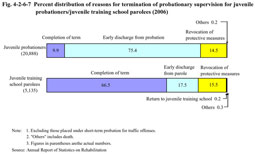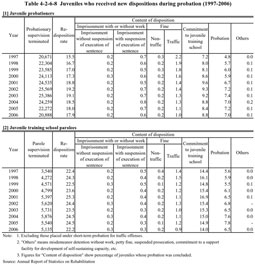| Previous Next Index Image Index Year Selection | |
|
|
3 Termination of probation/parole supervision for juveniles
(1) Reasons for termination
Fig. 4-2-6-7 shows the percent distribution of reasons for termination of probationary supervision for juvenile probationers/juvenile training school parolees in 2006. As for juvenile probationers, the percentage of those who were granted early discharge from probation has been around 75% since 1995. As for juvenile training school parolees, the percentage of those who were granted early discharge from parole (those whose parole was terminated earlier by a request from the director of a probation office and a decision by a Regional Parole Board) has been between 17% and 20% since 1996, and the percentage of those who completed the term has been around 65%.The percentage of those who were returned to a juvenile training school (those who were returned to a juvenile training school by the decision of a family court through the request of the director of a probation office and the application by a Regional Parole Board) or those who received revocation of protective measures (those whose former treatment was revoked because they were placed under new treatment due to repeating delinquency or offense) has been between 15% and 18% since 1998. There have been no significant changes in these percentages. Fig. 4-2-6-7 Percent distribution of reasons for termination of probationary supervision for juvenile probationers/juvenile training school parolees (2006) In 2006, good-conduct measures (temporary suspension of probation) were taken for 41 juvenile probationers, and notification to family court was implemented for 22 juvenile probationers due to new pre-delinquency (Source: The Rehabilitation Bureau, Ministry of Justice).(2) Percentage of those who received new dispositions Table 4-2-6-8 shows the percentage of those juvenile probationers/juvenile training school parolees who were placed under new protective measures (excluding return to juvenile training schools) or received criminal dispositions due to repeating offenses or delinquent acts during their probation/parole supervision among those whose probation/parole supervision was concluded, over the last 10 years. The percentage of those who received new dispositions had generally been on a downward trend until 1996 for both juvenile probationers and parolees, but as for juvenile probationers, it went up and has been between 17% and 20% since 1999, and as for juvenile parolees, it has generally been between 20% and 25% since 1997. Table 4-2-6-8 Juveniles who received new dispositions during probation (1997-2006) |

